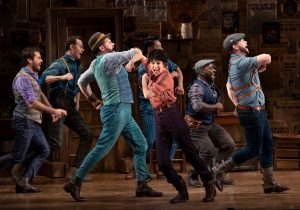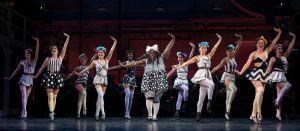
A few months ago I was flipping television channels and bumped into the opening song for The Unsinkable Molly Brown. I had not seen this movie for forty years and it is still wildly entertaining. I was looking forward to the Transport Group’s update to revitalize this 1960 musical theater chestnut. The 1964 film starred Debbie Reynolds as the indefatigable title character. History forever remembers her as a survivor from the sinking of the Titanic. The musical is based on her remarkable life story.
Tammy Grimes originated the role of Mrs. Brown on Broadway and won a Tony Award. Ms. Reynolds was Oscar nominated for her take on Molly. The character is bigger than life and allows an actress to sink her teeth into this plucky, feminist-forward lady. Beth Malone portrays her in this revival and the role suits her just fine. This Molly has energy and drive for days.
Dick Scanlan has rewritten the book and added new lyrics for this update. The adjustments are substantial. Only three lines of original dialogue remain. Less than half of the songs are from the 1960 musical. The rest are from the catalog of Meredith Wilson. An entertaining and slight biography now has deep messages thematically scrawled in big bold letters. Act II grinds to a dreadfully dull halt. Ms. Malone is a terrific Molly but, like the fateful ocean liner, she cannot prevent the sinking.
Directed and choreographed by Kathleen Marshall, the first act is largely fun and captures the spirit of this famous woman. The town’s miners note “there is no curse worse than a woman anywhere near a mine.” Molly eventually takes to the road and meets J.J. Brown (David Aron Damane). They marry and he discovers a gold mine. After becoming wealthy, they try to join the Denver social elite. As you would imagine, plucky is frowned upon by the snobbish women.
Prior to her high society quest, Molly is simply a great gal, tomboyish and non-judgmental. In the show’s best ensemble number, Molly befriends some saloon “workers” who join her in the raucous “Belly Up to the Bar, Boys.” This is the indomitable Molly who asks, “if I gotta eat catfish heads every day, can I have them on a plate just once?” The transition to join the “Beautiful People of Denver” is not smooth. Husband J.J. is not a fan of croquet. “I don’t want to play a game I can’t pronounce.
Molly and J.J. will have marital problems related to their increasingly divergent views on life. She decides to immerse herself in culture, escaping to Europe and becoming the toast of society there. The transatlantic trip home – and her reported bravery on the lifeboat – would endear her to Denver and forever keep her story well known.
An interesting tale about a woman who grabs life by the horns in a male dominated world is marred by slow pacing and preachy lessons. (You can successfully tell stories about women who navigate in a man’s oppressive world without being heavy handed. My review of the new Broadway musical Six will be published next week.) This Molly wants to be relevant now. How relevant? This line is plucked from today’s headlines: “If you don’t vote you can’t complain when officials do not reflect your intellect.” There is nothing inherently wrong with the notion. It’s just another thematic point loudly hammered home.
The cast is very good, especially Paula Leggett Chase in multiple scene stealing roles. I cannot recommend The Unsinkable Molly Brown due to a very dull second act. At intermission I was very engaged in the performances and the storytelling. Ideas were in short supply in the far less peppy second half. Plodding might be the best description.
“Colorado, My Home” is a glorious tune which was sung by the movie’s costar, Harve Presnell, who created the part of J.J. on Broadway. Trivia buffs might be interested to know that this song was dropped from the musical after opening night and restored for the movie version. (The song is left out here as well likely due to the vocal demands.)
I understand this fine Off-Broadway company wanted to create a new take on Molly Brown. In this instance I prefer the old-fashioned version. Find the movie, make some popcorn and discover the charms of this forgotten show. It’s not a Meredith Wilson classic like The Music Man but it is very fun.
The Transport Group’s production of The Unsinkable Molly Brown is being performed at the Abrons Arts Center through April 5, 2020.










You must be logged in to post a comment.